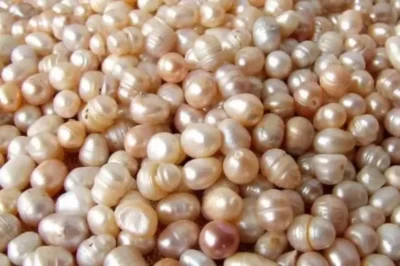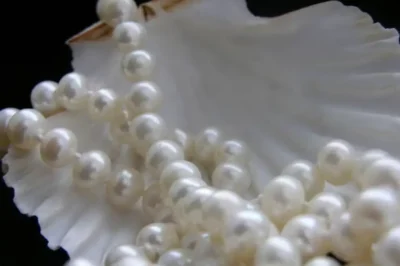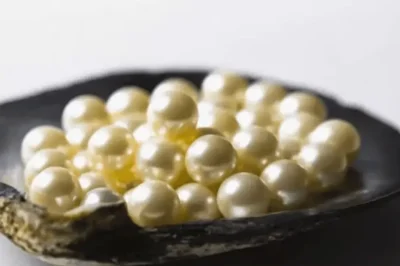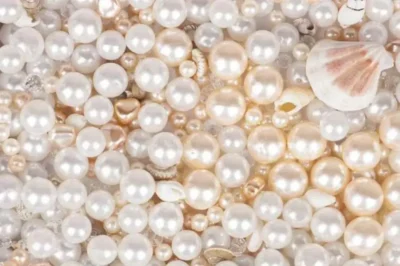TAKEAWAYS
Saltwater and freshwater pearls differ significantly in formation, characteristics, and value. Saltwater pearls grow in oysters in oceans and seas, while freshwater pearls develop in mussels in lakes and rivers.
Key differences include:
- Saltwater pearls: Higher luster, more perfectly round, more expensive, slower cultivation
- Freshwater pearls: Softer glow, varied shapes (baroque, oval), more affordable, thicker nacre
- Types: Saltwater includes Akoya, South Sea, and Tahitian; freshwater includes Biwa and Chinese varieties
- Colors: Saltwater offers classic white, gold, black; freshwater provides pastels, peach, lavender
Saltwater pearls are ideal for investment and classic jewelry due to their rarity and mirror-like shine. Freshwater pearls offer versatility and accessibility for everyday wear and creative designs.
Choose based on budget, style preference, and intended use—both types require gentle care to maintain their natural beauty.
Pearls have been captivating jewelry lovers for centuries with their natural elegance, luminous glow, and timeless charm. But if you’re shopping for pearls or just starting your jewelry collection, understanding the types of pearls is key to making informed choices. Among the most popular classifications are saltwater pearls and freshwater pearls, each with unique characteristics, beauty, and value.
In this ultimate guide, we’ll dive deep into the differences between saltwater and freshwater pearls, their unique qualities, how they are formed, and tips to choose the perfect pearls for your jewelry collection. Whether you’re a seasoned collector or a first-time buyer, this guide is your go-to resource for everything about pearls.
What Are Pearls? A Brief Overview
Before we get into the differences between saltwater and freshwater pearls, it’s important to understand what pearls actually are and why they’re so special.
Natural vs Cultured Pearls
Pearls are remarkable because they’re the only gemstones created by living organisms—oysters or mussels.
-
Natural Pearls: These are formed without human intervention, which makes them extremely rare and highly valuable. Natural pearls have a unique charm, but finding a flawless natural pearl is like finding a needle in a haystack.
-
Cultured Pearls: Most pearls on the market today are cultured. This means humans introduce an irritant into the oyster or mussel to stimulate pearl formation. Cultured pearls can be carefully nurtured to produce desired shapes, colors, and sizes, making them more accessible while retaining natural beauty.
How Pearls Are Formed
Pearl formation begins when an irritant—like a grain of sand—enters an oyster or mussel. The mollusk secretes nacre, a combination of aragonite and conchiolin, around the irritant, layer by layer, until a pearl is formed.
-
Saltwater Pearls: These grow inside oysters found in oceans and seas.
-
Freshwater Pearls: These develop in freshwater mussels, typically in lakes and rivers.
The environment in which the mollusk lives—saltwater or freshwater—greatly influences the pearl’s luster, shape, and overall beauty.
Saltwater Pearls: The Luxurious Choice
Saltwater pearls are often regarded as the epitome of elegance and luxury. They are typically more expensive than freshwater pearls because they grow more slowly and are rarer in nature.
Types of Saltwater Pearls
Saltwater pearls can be categorized into three main types:
-
Akoya Pearls:
-
Classic and timeless
-
Known for their perfectly round shapes and high luster
-
Typically used in necklaces and stud earrings
-
-
South Sea Pearls:
-
Large and luxurious, often 10–20mm in diameter
-
Colors range from white to golden
-
Famous for exceptional luster and smooth surfaces
-
-
Tahitian Pearls:
-
Exotic pearls from French Polynesia
-
Known for natural dark colors like black, gray, and peacock green
-
Unique and bold statement pieces
-
Characteristics of Saltwater Pearls
Saltwater pearls are prized for their:
-
Luster: Highly reflective surface that gives a bright, mirror-like shine

-
Roundness: More consistently round than freshwater pearls
-
Surface Quality: Fewer blemishes and imperfections
-
Color Variations: Wide range from classic white to rare black, gold, and silver
Price Range and Investment Value
Saltwater pearls are generally more expensive because they take longer to cultivate and are harvested in smaller quantities. Factors influencing price include:
-
Pearl size
-
Shape and roundness
-
Luster quality
-
Surface smoothness
-
Rarity of color
Saltwater pearls are often considered a good investment for collectors due to their high resale value and enduring demand.
Freshwater Pearls: Versatile and Affordable
Freshwater pearls offer an attractive alternative to saltwater pearls, combining charm, variety, and affordability.
Types of Freshwater Pearls
Freshwater pearls are primarily cultured in China and Japan and come in various types:
-
Biwa Pearls: Japanese freshwater pearls, known for their soft luster
-
Chinese Freshwater Pearls: The most common type today, available in a variety of shapes and sizes
-
Other notable varieties include Keshi pearls, prized for their unique baroque forms
Characteristics of Freshwater Pearls
Freshwater pearls are loved for their:
-
Shapes: Baroque, semi-round, and irregular shapes create unique, artistic jewelry
-
Color Range: White, cream, peach, lavender, and pastel hues
-
Nacre Thickness: Thicker nacre than most Akoya pearls, making them durable and long-lasting
Price and Accessibility
Freshwater pearls are generally more affordable than saltwater pearls, making them ideal for:
-
Everyday jewelry
-
Trendy, multi-strand designs
-
Buyers seeking variety without a high price tag
Although they are less expensive, quality freshwater pearls can still achieve a beautiful, lustrous finish that rivals saltwater pearls.
Saltwater vs Freshwater Pearls – Key Differences
Choosing the right pearl often comes down to understanding the key differences between saltwater and freshwater pearls.
Luster and Surface Quality
-
Saltwater Pearls: Higher luster, smoother surface, and mirror-like shine
-
Freshwater Pearls: Softer, gentle glow; may have minor surface imperfections
Shape and Size Options
-
Saltwater Pearls: Typically perfectly round; fewer irregular shapes
-
Freshwater Pearls: Wide variety of shapes, including baroque and oval, often with unique textures
Color and Iridescence
-
Saltwater Pearls: Classic white, golden, black, and silver shades with subtle iridescence
-
Freshwater Pearls: Pastel colors, peach, lavender, and cream; some have unique rainbow overtones
Durability and Care
-
Saltwater Pearls: Slightly softer; require careful handling to prevent scratches
-
Freshwater Pearls: Thicker nacre; more durable for everyday wear
Price Comparison
Saltwater pearls are more expensive due to rarity and slow cultivation, while freshwater pearls are budget-friendly yet elegant and versatile.
Choosing the Right Pearl for You
When deciding between saltwater and freshwater pearls, consider your needs, style, and budget.
Purpose: Jewelry Style Considerations
-
Necklaces: Round Akoya or South Sea pearls offer timeless elegance
-
Earrings: Freshwater pearls provide creative, affordable designs
-
Bracelets & Rings: Baroque freshwater pearls offer unique, artistic appeal
Budget and Investment Potential
-
Saltwater pearls are a long-term investment
-
Freshwater pearls are accessible for fashion jewelry and trendy pieces
Personal Taste and Aesthetic
-
Match pearl color and shape to skin tone and wardrobe
-
Consider jewelry style: classic vs modern, minimalist vs statement
Authenticity and Certification Tips
-
Check for certificates of authenticity from trusted labs
-
Verify whether the pearl is cultured or natural
-
Understand grading for luster, size, and surface quality
Caring for Your Pearls
Pearls are delicate gemstones and need proper care to maintain their beauty.
-
Cleaning: Use a soft, damp cloth; avoid harsh chemicals
-
Storage: Store separately from other jewelry to prevent scratches
-
Handling: Avoid contact with perfumes, hairspray, and cosmetics
-
Longevity: Regular wear helps pearls retain luster, but proper care ensures they last generations
Conclusion
Understanding the types of pearls, especially the differences between saltwater and freshwater varieties, is essential for making confident, informed purchases.
-
Saltwater Pearls: Luxurious, high-luster, perfect for investment and classic jewelry
-
Freshwater Pearls: Versatile, budget-friendly, ideal for creative and everyday designs
Whether you choose the timeless elegance of saltwater pearls or the artistic charm of freshwater pearls, knowing their characteristics, care tips, and value ensures you select pearls that bring beauty, joy, and sophistication to your collection.
Now that you know the differences, you can confidently choose the perfect pearls for your jewelry box or next special gift. After all, pearls are more than just gemstones—they are a symbol of elegance, grace, and timeless style.
FAQ Section (SEO Boost)
Q1: Which pearls are more valuable, saltwater or freshwater?
Saltwater pearls are generally more valuable due to their rarity, slower growth, and higher luster.
Q2: How can I tell if a pearl is freshwater or saltwater?
Consider size, shape, luster, and surface quality. Saltwater pearls are typically rounder and shinier, while freshwater pearls may be irregular and have softer luster.
Q3: Do freshwater pearls last as long as saltwater pearls?
Yes, with proper care, freshwater pearls can last decades, though saltwater pearls are slightly more delicate.
Q4: What colors do saltwater and freshwater pearls come in?
Saltwater: white, cream, gold, black, silver
Freshwater: white, peach, lavender, cream, and pastel rainbow overtones
Q5: Are pearls a good investment?
Saltwater pearls are considered excellent investments due to rarity and long-term value. Freshwater pearls are more affordable but may not appreciate as much over time.






